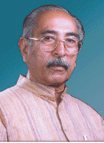SAMMELANS & CONFERENCES
By Dr. Satish Rohra

Instead of stating something at today’s conference I would rather ask a question. I ask myself this question and I want to ask you this question.
The question is why have we gathered here today? We, the same lot of people, why do we meet every year? Year after year, after meeting some old and new friends, eating drinking, listening to some speeches, some songs etc, we return to our own ways. After all, why do we do all this? What do we get out of it all? What do we expect out of such gatherings and what do we actually get out of them? We have been doing this all along and perhaps we shall continue to do so in the future. For what? How are the Sindhis benefitting from this? After hearing my question you too must be wondering why you have taken so much trouble and spent money to come here. For what?
OK, lets keep this question aside for a while. Now I ask you another question, which is not very difficult to answer. The question is why do we join any celebration or mourning of some near and dear one? This is easy to answer. We do so because we wish the other to realize that we are friends and we share his joys and sorrows as our own. It is not important what relationship we have with him. Maybe he is just a close friend. What is important is that we share a close relationship. By joining him in his joys and sorrows we wish to authenticate that relationship. In some way we want to feel related and remain connected to each other. Which means that we are not alone, we are a part of a larger family. By feeling a part of a larger family we feel stronger, more confident and socially important.
Now I come back to my previous question. Why have we come here? Or why do we meet every year in some of the other country? Do we want to stress that we are related to each other? Yes, at such gatherings we wish to tell each other that we are Sindhis. We want to emphasize and remind each other that we all Sindhis are related to each other and it is this relationship that connects one to the other. Through this relationship of Sindhyat all Sindhis are thus related to each other. Through these conferences Sindhis express their solidarity and make each other feel that through this bond of Sindhyat they are related and connected and that they are part of one large family.
Some of you may want to know what is this Sindhyat through which we are connected and related. It is a reasonable question. Let me emphasize that just as relationship is not a thing, in the same way Sindhyat too is not a thing. The meaning of Sindhyat is not some Sindhi song, Sindhi art or Sindhi dance. Sindhyat is some sort of thought or feeling because of which I consider myself a Sindhi. Sindhyat means that behaviour because of which I am a Sindhi and because of which other consider me a Sindhi. This is not a suddenly acquired behaviour, but is a result of Sindhi culture over the centuries which I have got as heritage from my elders. Let us now consider how ancient this culture is and what is the nature of this behaviour.
It is undoubtedly an accepted fact that the Vedas are the oldest documents of the world and they were written on the banks of the Sindhu river. Vedas are considered to be 5,000 to 10,000 years old. The oldest Veda is the Rig Veda in which the Sindhu river has been praised a lot. Which means that Sindh and Sindhu river were present before the creation of Vedas.
Following the Vedas are the Ramayan and Mahabharat. It has now come to light that Lord Ram and Sita had visited Sindh and King Ram had handed over the kingdom of Sindh to his brother Bharat. It has also come to light that Bharat’s mother was from the state of Kaikayi and therefore she was named Kaikayi which was part of Sindhu desh.
In 1922 John Marshal had come across ruins near Larkana and he discovered the oldest and the most progressive civilization called the Sindhu valley of Indus Valley civilization, called Mohen-Jo-Daro which is considered around 25,000 years old. The city of Mohen-Jo-Daro is not one, but created and destroyed seven times. It must have taken a long time for this city to be destroyed and rebuilt seven times! But to be destroyed and rebuild is nothing new for Sindhis. Those who had seen Gandhidham before the earthquake will not believe their eyes when they see how beautiful it is now. There is a Sindhi saying ‘Those who drown are doubled’. In Sindh, after the floods the land would become fertile and in the following year the harvest would be twice as much. In the same way, when old buildings fall the new buildings that come in their place are more valuable and command a higher price.
This means being uprooted and redeveloping is a part of Sindhi nature. During the partition, lakhs of Sindhis had to leave their motherland and today Sindhis are found in 150 nations of the world and are truly successful everywhere. Yes, we have become distant from each other and with such international conferences we travel from different nations to come and be together, reminding each other that because we are Sindhis we are close friends and relations. Such international conference give us a chance to feet that YES WE ARE. . . . . . .YES WE ARE SINDHIS.


